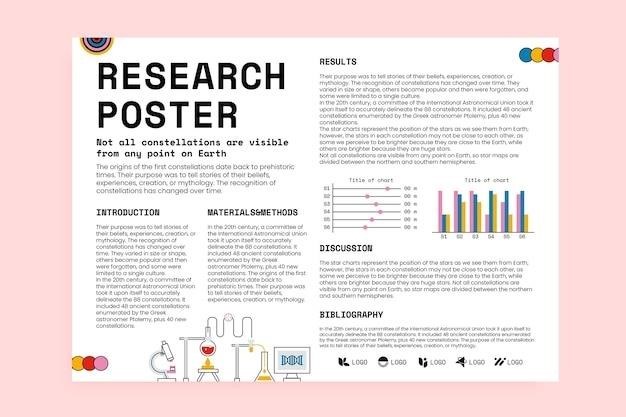Competitive Analysis Example PDF⁚ A Structured Approach
A structured competitive analysis identifies and analyzes competitors to inform strategic decision-making. This involves examining competitor strategies, strengths, weaknesses, marketing, and the market environment to develop competitive advantages. Downloadable PDF templates can streamline this process.
Defining Objectives and Scope
Defining clear objectives and scope is paramount for an effective competitive analysis. Before diving into research, pinpoint the specific goals you aim to achieve. Are you launching a new product and need to understand existing market players? Are you trying to improve market share and need to identify vulnerabilities in competitors’ strategies? Clearly stating your objectives will guide your research and ensure relevant data collection.

The scope defines the boundaries of your analysis. Which competitors will you focus on—direct rivals, indirect competitors, or both? Will you analyze a specific geographic region or product segment? Consider the resources and time available. A narrowly defined scope, for example, focusing on key competitors in a specific geographic market, can yield more focused and actionable insights compared to a broad, less manageable analysis. Documenting the scope helps maintain focus and prevents scope creep, ensuring the analysis remains efficient and relevant to your objectives.
For instance, if your objective is to increase market share for a specific product in a particular region, your scope might include analyzing the top three direct competitors in that region, focusing on their pricing strategies, marketing campaigns, and customer service approaches. This focused approach will provide actionable insights to inform your competitive strategy.

Identifying Direct and Indirect Competitors
Identifying competitors is a crucial step in a competitive analysis. Start by pinpointing your direct competitors—businesses offering similar products or services to the same target market. For example, if you sell organic coffee beans online, your direct competitors are other online retailers selling organic coffee beans.
Next, consider indirect competitors. These businesses might offer different products or services, but they still fulfill the same customer need. In the organic coffee example, indirect competitors could include local cafes, instant coffee brands, or even tea companies. While not directly competing on the same product, they offer alternative solutions to the customer’s need for a caffeinated beverage.
Thorough identification of both direct and indirect competitors provides a comprehensive view of the competitive landscape. Consider using various resources to compile a comprehensive list⁚ online searches, industry reports, trade publications, customer surveys, and social media monitoring. For example, searching for relevant keywords on Amazon can reveal direct competitors, while analyzing customer reviews can highlight alternative solutions they consider, revealing indirect competitors.
Accurately identifying both direct and indirect competitors is essential for understanding the full range of competitive pressures and formulating effective competitive strategies.
Analyzing Competitor Strategies
Analyzing competitor strategies is key to understanding their market positioning and potential reactions to your business actions. This involves examining their product/service offerings, pricing strategies, marketing efforts, and overall business models.
Start by examining their product/service portfolio. What features do they offer? What are their strengths and weaknesses? How do they differentiate themselves? For example, a competitor might focus on premium quality, while another emphasizes affordability.
Next, analyze their pricing strategies. Are they premium priced, value-oriented, or somewhere in between? How do their prices compare to yours and other competitors? Understanding their pricing models helps anticipate their reactions to price changes in the market.
Investigate their marketing and sales tactics. What channels do they use (social media, advertising, email marketing)? What is their brand messaging? Understanding their marketing approach reveals their target audience and how they communicate value. For instance, a competitor focusing on social media marketing might be targeting a younger demographic.
Finally, consider their overall business model. Are they focused on online sales, brick-and-mortar stores, or a hybrid approach? Understanding their business model reveals their operational structure and potential vulnerabilities.
Assessing Competitor Strengths and Weaknesses
Assessing competitor strengths and weaknesses is crucial for identifying opportunities and threats in the marketplace. This analysis provides insights into areas where your business can excel and potential vulnerabilities to exploit.
Begin by identifying competitor strengths. These are areas where they outperform the competition. Examples include strong brand recognition, a wide product range, efficient operations, or a loyal customer base. Understanding their strengths helps determine areas where you need to improve to compete effectively.
Next, pinpoint their weaknesses. These are areas where competitors are underperforming or vulnerable. Examples include outdated technology, poor customer service, limited marketing reach, or high operating costs. Identifying weaknesses reveals potential opportunities for your business to gain a competitive edge.
Use a SWOT analysis framework to organize your findings. A SWOT analysis examines Strengths, Weaknesses, Opportunities, and Threats. This framework provides a structured approach to understanding the competitive landscape and developing strategies to capitalize on competitor weaknesses and mitigate potential threats.
Consider using online resources and competitive analysis templates to streamline the process. These resources can provide pre-built frameworks and examples to guide your analysis. For example, downloadable PDF templates can help organize your findings and present them in a clear and concise format.
Evaluating Competitor Marketing and Sales
Evaluating competitor marketing and sales strategies provides crucial insights into their target audience, messaging, and overall market positioning. This analysis helps understand how competitors attract and retain customers, informing your own marketing and sales efforts.
Examine their marketing channels. Do they primarily use social media, email marketing, content marketing, or traditional advertising? Analyzing their channel mix helps understand their target audience and preferred communication methods. For example, a competitor focusing on social media may be targeting a younger demographic.
Analyze their messaging and branding. What is the tone and style of their communication? What are their key brand messages and values? Understanding their messaging helps identify their unique selling propositions and how they differentiate themselves in the market.
Investigate their sales tactics. Do they offer discounts, promotions, or personalized recommendations? Understanding their sales strategies helps determine how they convert leads into customers. For example, a competitor offering frequent discounts might be targeting price-sensitive customers.
Utilize online resources and competitive analysis templates to streamline this process. These resources can provide pre-built frameworks and examples to guide your analysis. Downloadable PDF templates can help organize your findings and present them in a clear and concise format, enabling informed decision-making for your own marketing and sales strategies.
Understanding the Regulatory Environment
Analyzing the regulatory environment is crucial for a comprehensive competitive analysis. Regulations, legal frameworks, and industry standards significantly impact market dynamics and competitive landscapes. Understanding these influences allows businesses to anticipate challenges, identify opportunities, and make informed strategic decisions.
Identify relevant regulations. Research industry-specific regulations, licensing requirements, and legal restrictions that apply to both your business and your competitors. For example, environmental regulations might impact manufacturing processes, while data privacy laws can affect how customer information is handled.
Analyze the impact of regulations. Assess how existing and upcoming regulations might affect market entry barriers, competition intensity, and profitability. For instance, stringent regulations could increase the cost of doing business, limiting smaller competitors’ ability to compete.
Evaluate competitor compliance. Examine how competitors adhere to existing regulations. This can reveal potential vulnerabilities or opportunities for differentiation. For example, a competitor struggling with compliance might face penalties or reputational damage, creating an opening for your business.
Monitor regulatory changes. Stay informed about upcoming regulatory changes and anticipate their potential impact on the competitive landscape. This proactive approach enables businesses to adapt quickly and maintain a competitive edge. Utilize online resources and competitive analysis templates to stay updated on regulatory developments and streamline your analysis. Downloadable PDF examples can provide structured frameworks for organizing your findings and facilitating informed decision-making.
Examining Customer and Supplier Power
Understanding customer and supplier power is crucial within a competitive analysis. These forces significantly influence pricing, profitability, and competitive dynamics. By analyzing these power dynamics, businesses can develop strategies to mitigate potential risks and leverage opportunities.
Customer Power⁚ Assess the degree of influence customers hold over pricing and purchasing decisions. High customer power can drive down prices and erode profit margins. Consider factors like customer concentration, switching costs, and availability of substitutes.
Supplier Power⁚ Evaluate the influence suppliers have over input costs and availability. Powerful suppliers can command higher prices and restrict supply, impacting a business’s profitability and competitiveness. Analyze factors like supplier concentration, the availability of substitute inputs, and the importance of the input to your business.
Balancing Power Dynamics⁚ Develop strategies to mitigate the negative effects of high customer or supplier power. For instance, businesses can build strong relationships with multiple suppliers to reduce dependence on a single source. Similarly, customer loyalty programs can reduce customer power and increase switching costs.
Competitive Advantage⁚ Use insights gained from analyzing customer and supplier power to identify potential competitive advantages. For example, if your competitors are heavily reliant on a single powerful supplier, securing alternative supply sources can give your business a significant edge. Downloadable PDF examples of competitive analyses can provide structured frameworks for assessing and incorporating these power dynamics into your strategic planning.
Identifying Market Trends and Opportunities
A crucial aspect of competitive analysis involves identifying key market trends and potential opportunities. This proactive approach allows businesses to anticipate future market shifts and adapt their strategies accordingly. Understanding emerging trends can reveal untapped market segments, new product possibilities, and innovative marketing approaches.
Trend Analysis⁚ Analyze various factors such as technological advancements, regulatory changes, and evolving consumer preferences to identify emerging trends. Use market research data, industry reports, and competitor analysis to gain insights into these shifts.
Opportunity Identification⁚ Based on identified trends, pinpoint potential opportunities for growth and competitive advantage. These opportunities may involve developing new products or services, entering new market segments, or adopting innovative marketing strategies.
Competitive Advantage⁚ By recognizing and capitalizing on market trends before competitors, businesses can gain a significant competitive edge. Early adoption of new technologies or catering to emerging customer needs can establish market leadership and drive growth.
Strategic Planning⁚ Integrate identified market trends and opportunities into your overall strategic planning process. Develop specific strategies and action plans to capitalize on these insights and achieve your business objectives. Downloadable PDF examples of competitive analyses can provide frameworks for identifying and incorporating market trends and opportunities into strategic decision-making.
Developing Competitive Advantages
The ultimate goal of competitive analysis is to develop sustainable competitive advantages. These advantages allow a business to outperform rivals and achieve long-term success. By leveraging insights gained from the analysis, companies can identify areas where they can differentiate themselves and create unique value for customers.
Differentiation Strategies⁚ Focus on developing unique product features, superior customer service, or innovative marketing approaches to stand out from the competition. Analyze competitor weaknesses and identify areas where you can offer superior value.
Cost Leadership⁚ Explore opportunities to reduce costs and offer competitive pricing without compromising quality. Streamlining operations, optimizing supply chains, and leveraging technology can contribute to cost leadership.
Niche Market Focus⁚ Consider specializing in a specific niche market to cater to a particular customer segment’s unique needs. This focused approach can allow businesses to build expertise and establish a strong market presence within the niche.
Innovation and Adaptation⁚ Continuously innovate and adapt to evolving market dynamics. Monitor competitor activities, anticipate future trends, and be prepared to adjust your strategies to maintain a competitive edge. Referencing competitive analysis examples in PDF format can provide valuable insights and frameworks for developing effective competitive advantage strategies.
